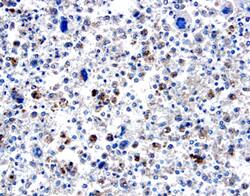Human BMP-8 Antibody
R&D Systems, part of Bio-Techne | Catalog # AF1073


Key Product Details
Species Reactivity
Validated:
Cited:
Applications
Validated:
Cited:
Label
Antibody Source
Product Specifications
Immunogen
Ala264-His402
Accession # AAP74559
Specificity
Clonality
Host
Isotype
Scientific Data Images for Human BMP-8 Antibody
BMP‑8 in Human Osteo-sarcoma.
BMP-8 was detected in immersion fixed paraffin-embedded sections of human osteosarcoma using 15 µg/mL Goat Anti-Human BMP-8 Antigen Affinity-purified Polyclonal Antibody (Catalog # AF1073) overnight at 4 °C. Tissue was stained with the Anti-Goat HRP-DAB Cell & Tissue Staining Kit (brown; Catalog # CTS008) and counterstained with hematoxylin (blue). View our protocol for Chromogenic IHC Staining of Paraffin-embedded Tissue Sections.Applications for Human BMP-8 Antibody
Immunohistochemistry
Sample: Immersion fixed paraffin-embedded sections of human osteosarcoma
Western Blot
Sample: Recombinant Human BMP-8
Formulation, Preparation, and Storage
Purification
Reconstitution
Formulation
Shipping
Stability & Storage
- 12 months from date of receipt, -20 to -70 °C as supplied.
- 1 month, 2 to 8 °C under sterile conditions after reconstitution.
- 6 months, -20 to -70 °C under sterile conditions after reconstitution.
Background: BMP-8
BMP-8, also known as osteogenic protein 2 (OP-2), was first isolated from a hippocampal library in a screen to identify relatives of BMP-7 (OP-1) (1). BMPs are a family of structurally and functionally related proteins and represent a subfamily of the transforming growth factor beta (TGF-beta) superfamily. BMPs were originally identified as protein regulators of cartilage and bone formation. They have since been shown to be involved in embryogenesis and morphogenesis of various tissues and organs (2). BMPs play roles in regulating growth, differentiation, chemotaxis, and apoptosis of various cell types, including mesenchymal, epithelial, hematopoetic, and neuronal cells.
There exist two highly related and closely linked genes, designated BMP-8a and -8b in mice and humans. For humans, the protein products of these two genes share 98% amino acid (aa) sequence identity in their pro- and mature regions. However in the mouse, the two proteins share 89% and 76% aa sequence homology in their pro- and mature regions, respectively (3). Mature human BMP-8a shares 91% and 70% aa sequence identity with mouse BMP-8a and -8b, respectively. Human BMP‑8a is synthesized as a large precursor protein that is cleaved at a dibasic cleavage site (RTPR) between aa residues 263 and 264 to release a 139 aa carboxy-terminal domain. Expression patterns of the BMP-8 genes indicate that they regulate aspects of cell proliferation and/or differentiation during spermatogenesis and formation of the placenta (3). BMP-8 is also highly expressed in osteosarcomas (4).
References
- Ozkaynak, E. et al. (1992) J. Biol. Chem. 267:25220.
- Canalis, E. et al. (2003) Endocrine Rev. 24:218.
- Zhao, G-Q. et al. (1996) Mech. Dev. 57:159.
- Sulzbacher, I. et al. (2002) J. Clin. Pathol. 55:381.
Long Name
Alternate Names
Gene Symbol
UniProt
Additional BMP-8 Products
Product Documents for Human BMP-8 Antibody
Product Specific Notices for Human BMP-8 Antibody
For research use only